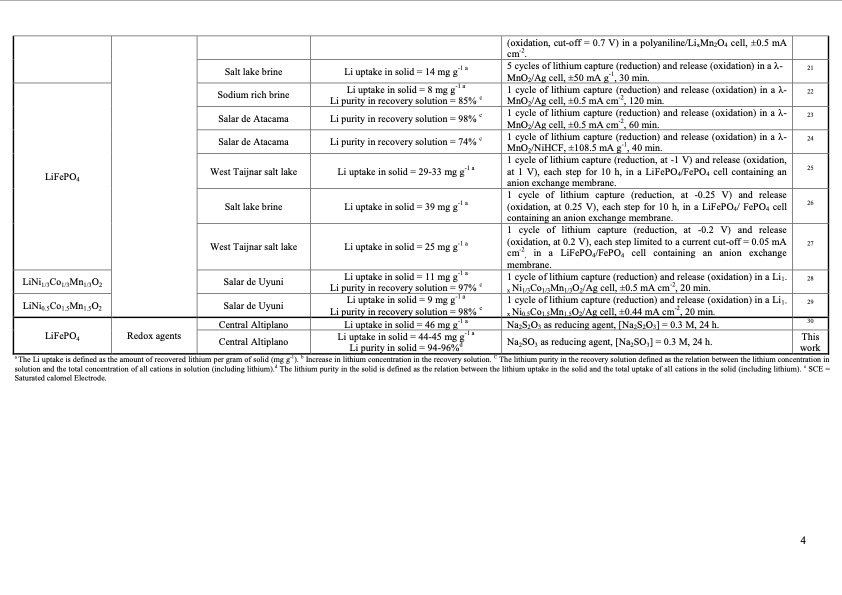
PDF Publication Title:
Text from PDF Page: 004
Salt lake brine Sodium rich brine Salar de Atacama Salar de Atacama -1 a Li uptake in solid = 8 mg g-1 a Li purity in recovery solution = 85% c (oxidation, cut-off = 0.7 V) in a polyaniline/LixMn2O4 cell, ±0.5 mA cm-2. 5 cycles of lithium capture (reduction) and release (oxidation) in a λ- 21 MnO2/Ag cell, ±50 mA g-1, 30 min. Li uptake in solid = 14 mg g Li purity in recovery solution = 98% Li purity in recovery solution = 74% MnO2/Ag cell, ±0.5 mA cm-2, 120 min. c 1 cycle of lithium capture (reduction) and release (oxidation) in a λ- 23 MnO2/Ag cell, ±0.5 mA cm-2, 60 min. c 1 cycle of lithium capture (reduction) and release (oxidation) in a λ- 24 MnO2/NiHCF, ±108.5 mA g-1, 40 min. 1 cycle of lithium capture (reduction) and release (oxidation) in a λ- 22 West Taijnar salt lake Li uptake in solid = 29-33 mg g-1 a 1 cycle of lithium capture (reduction, at -1 V) and release (oxidation, at 1 V), each step for 10 h, in a LiFePO4/FePO4 cell containing an anion exchange membrane. Salt lake brine Li uptake in solid = 39 mg g-1 a 1 cycle of lithium capture (reduction, at -0.25 V) and release (oxidation, at 0.25 V), each step for 10 h, in a LiFePO4/ FePO4 cell containing an anion exchange membrane. West Taijnar salt lake Li uptake in solid = 25 mg g-1 a 1 cycle of lithium capture (reduction, at -0.2 V) and release (oxidation, at 0.2 V), each step limited to a current cut-off = 0.05 mA cm-2, in a LiFePO4/FePO4 cell containing an anion exchange membrane. LiFePO4 25 26 27 LiNi Co 1/3 Mn O 1/3 1/3 Salar de Uyuni Salar de Uyuni Central Altiplano Central Altiplano Li uptake in solid = 11 mg g-1 a Li purity in recovery solution = 97% c Li uptake in solid = 9 mg g-1 a Li purity in recovery solution = 98% c Li uptake in solid = 46 mg g-1 a Li uptake in solid = 44-45 mg g-1 a Li purity in solid = 94-96%d 1 cycle of lithium capture (reduction) and release (oxidation) in a Li1- 28 x Ni1/3Co1/3Mn1/3O2/Ag cell, ±0.5 mA cm-2, 20 min. 1 cycle of lithium capture (reduction) and release (oxidation) in a Li1- 29 x Ni0.5Co1.5Mn1.5O2/Ag cell, ±0.44 mA cm-2, 20 min. Na2S2O3 as reducing agent, [Na2S2O3] = 0.3 M, 24 h. 30 This Na2SO3 as reducing agent, [Na2SO3] = 0.3 M, 24 h. work 2 LiNi0.5Co1.5Mn1.5O2 LiFePO4 Redox agents a The Li uptake is defined as the amount of recovered lithium per gram of solid (mg g-1). b Increase in lithium concentration in the recovery solution. C The lithium purity in the recovery solution defined as the relation between the lithium concentration in solution and the total concentration of all cations in solution (including lithium).d The lithium purity in the solid is defined as the relation between the lithium uptake in the solid and the total uptake of all cations in the solid (including lithium). e SCE = Saturated calomel Electrode. 4PDF Image | Novel method of lithium production from brines

PDF Search Title:
Novel method of lithium production from brinesOriginal File Name Searched:
MS_v9_ref.pdfDIY PDF Search: Google It | Yahoo | Bing
Product and Development Focus for Infinity Turbine
ORC Waste Heat Turbine and ORC System Build Plans: All turbine plans are $10,000 each. This allows you to build a system and then consider licensing for production after you have completed and tested a unit.Redox Flow Battery Technology: With the advent of the new USA tax credits for producing and selling batteries ($35/kW) we are focussing on a simple flow battery using shipping containers as the modular electrolyte storage units with tax credits up to $140,000 per system. Our main focus is on the salt battery. This battery can be used for both thermal and electrical storage applications. We call it the Cogeneration Battery or Cogen Battery. One project is converting salt (brine) based water conditioners to simultaneously produce power. In addition, there are many opportunities to extract Lithium from brine (salt lakes, groundwater, and producer water).Salt water or brine are huge sources for lithium. Most of the worlds lithium is acquired from a brine source. It's even in seawater in a low concentration. Brine is also a byproduct of huge powerplants, which can now use that as an electrolyte and a huge flow battery (which allows storage at the source).We welcome any business and equipment inquiries, as well as licensing our turbines for manufacturing.| CONTACT TEL: 608-238-6001 Email: greg@infinityturbine.com | RSS | AMP |